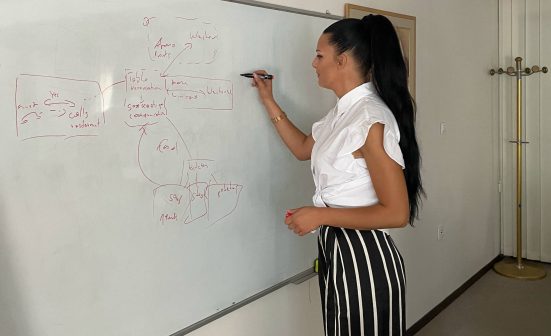CHALLENGE YOURSELF. TAKE IT TO THE NEXT LEVEL.
Client: Medical device development company
Sector: Highly regulated industry
Year: 2021
Involved people: 150
Involved Departments: Software, Hardware, Electronics, Electrics, Mechanics, System, Testing, Engineering, Requirements Engineering, Design Engine, Verification, Regulatory Affairs, Product Management, Global Product Management
s(t) is like keeping track of how far something has moved from where it started. It tells you the total distance traveled up to a certain time.v(t) is how fast that something is going at any specific time. It's like checking the speedometer of a car - it tells you how fast the car is moving at that exact moment.a(t) is how quickly the speed of that something is changing at any time. It's like feeling the car either speed up or slow down - it tells you how quickly the car is picking up speed or slowing down.
By understanding these functions, you can better analyze how far something has traveled, how fast it’s going, and how quickly its speed is changing. This understanding can help you make informed decisions about managing progress and resources effectively and ensuring timely and efficient operations.
We assisted our client in establishing strong interdependency and adaptiveness in their system engineering through the implementation of Socioeconomic Kanban Systems.

As previously discussed, we have introduced a suitable digitalization tool. The combination of digitizing workflows and aligning delivery dates is essential for scalability of Socioeconomic Kanban Systems.
Linear regression is a tool in data analysis that helps us understand how certain factors influence an outcome. This helps management make better decisions based on data and predict outcomes more accurately.
Linear regression is a method used in data analysis to understand and predict how one thing (let’s call it “A”) is influenced by other things (let’s call them “B” and “C”). It helps us figure out how changes in B and C affect A.
The variety theorem describes the relationships between disturbances Sn acting on a system, the possible system reactions Rn and the resulting consequences Kn.
A deeper look at the client’s challenges includes silos and dissatisfaction with the agile approach and erosion of trust
Problems of our costumer
Critical client perspectives underscore significant concerns regarding the organization’s capability to honor commitments, meet deadlines, and provide a seamless client experience. Involved departments operate with distinct processes, priorities, and delivery schedules. From the client’s critical viewpoint, doubts arise concerning the organization’s capacity to deliver value, adhere to deadlines, and maintain transparency, ultimately impacting the overall client experience. Employee trust in the organization’s hierarchy is diminishing, resulting in an escalating employee churn rate.
Goals of the transformation
The goal of the project, "Building Invincible Interdependency and Adaptiveness for System Engineering Through Socioeconomic Kanban Systems," is to achieve significant time savings across multiple departments. By adopting innovative methodologies, the project aims to enhance operational efficiency and adaptability to the constantly changing business environment. The primary objective is to ensure that the systems in use effectively tackle today's socioeconomic challenges and remain robust in the face of future uncertainties, ultimately delivering value and dependability.
Resource Reliability
Steep Learning Curve
Adaption Zone
Adaption Zone
Streamlining Product Development for Faster Results: Our Consultation Approach
Our first corner stone was quickly grasping the company’s normative and formative structures. This understanding is essential for achieving our goals.
Improving effectiveness, and enhancing adaptability, which are critical for successfully implementing Socioeconomic Kanban Systems.
The department-specific challenges underscore the necessity for targeted solutions and better inter-departmental collaboration to boost overall product development performance. As a response, we have introduced Adaption Zones.
As previously discussed, we have introduced a suitable digitalization tool. The combination of digitizing workflows and aligning delivery dates is essential for scalability with Socioeconomic Kanban Systems.
These "Adaptation Zones" involve identifying subsystems, mapping dependencies, evaluating their necessity, and determining integration sequences to achieve the client's change goals effectively.
Streamlining Product Development for Faster Results: Our Consultation Approach
In summary, our consulting perspective places the changing part of the organization at the centre of our efforts. We aim to deliver customized solutions that not only optimize the clients product development process but also foster a culture of continuous improvement and adaptability. Our approach blends technical expertise with a deep understanding of the social and economic dynamics within the analysed organization part, resulting in enduring early engagement of all hierarchical levels.
Maximum Standardisation
Standardized Development: A structured approach to development is followed, ensuring consistency and quality. such as Standard Operating Procedures (SOP), Medical Device Regulation (MDR), IEC 62366-1:2015 compliance, and Failure Modes and Effects Analysis (FMEA). Shared Knowledge: There's a culture of sharing knowledge and "how things are done around here," promoting collaboration and continuity.
Understanding How Things Work
Top-Down Authority: The organization currently relies on top-down decision-making, ensuring a unified approach to achieving your goals. Strategic Focus: There's a strong emphasis on aligning the efforts with overall strategy and preparing for worst-case scenarios. Normative Structures: The organization has established norms or standards that guide behavior, including a clear self-concept and an organizational matrix defining roles and relationships. Formative Structures: Critical processes and documentation are in place.
Data-driven
Target dates are set based on specific events or milestones, facilitating timely responses. Teams closest to problems react quickly, ensuring issues are addressed promptly. Reducing the elapsed time between making a decision to seeing results the con- sequences of that decision.
Socioeconomic Kanban Systems

The leverage of Kanban systems is deeply correlated with the product development strategy. Master the concept of ‘Waiting’ in all systems and aggregate the waitings into clusters. Prioritize the resolution of waiting clusters.
Ensuring economic thinking at all levels
Compliance and regulatory matters are seamlessly integrated into our workflow, ensuring that we meet evolving legal and industry standards and ensure meeting the target and reaction time. We convey a commitment to both regulatory compliance and operational effectiveness.
We could support our client in accelerating due to the Socioeconomic Kanban Systems architecture, which is based on the Progression of Unpredictability = (Loss of Effectiveness * Uncertainty * Time * Costs).
The basic functioning of the Socioeconomic Kanban System involves functions, structures, a monitored feedback system, and economic thinking at all levels by focusing on different timeframes.
The effects by scaling knowledge work with Socioeconomic Kanban System for our Client.
Emergent change: Dealing with challenges that emerge, often have a disruptive character, which for the organisations need to prepare. The change capabilities have an infrastructural character. Adaptive cycle seeks for speedy new combinations.
- Due date
- Reaction time
- Response time
- Target Date
- Delivery date
- Target dates (within units)
- Adaptivity in real time
- Time2Value
- Time2Market
- Data driven forecasting
In organizational changes, the function of time is essential in understanding the dynamics and patterns of the change process. Here is a concise explanation:
Time serves as a critical parameter in organizational changes, influencing the pace, duration, and outcomes of transitions within the organization. It helps track the evolution of strategies, the implementation of new processes, and the adaptation of employees to the changes. Understanding the function of time in organizational changes aids in effective planning, timely execution, and the assessment of the impact of changes on the overall performance and success of the organization.


